Atlantic Monthly Contributors's Blog, page 127
July 6, 2016
Britain's Iraq War Reckoning

What we know:
—Britain’s long-awaited Chilcot report found former Prime Minister Tony Blair joined the U.S.-led invasion before “peaceful options” to disarm Saddam Hussain had been exhausted.
—The report says there was “no imminent threat” from Iraq before the war started and its legal justifications were "far from satisfactory.”
—Parliament is planning two days of debate on the report’s findings.
—In a statement, Blair said he will “accept full responsibility, without exception and without excuse.”
—The full report can be read here.
—We’re live-blogging the major findings, and you can read how it all unfolded below. All updates are in Eastern Standard Time (GMT -5).
4:36 p.m.
The inquiry’s report offers the most comprehensive timeline yet on how the British government’s top lawyer came to support the legal basis for the Iraq War. While it did not weigh in on whether the war itself was lawful, the inquiry described the conditions in which that determination was made as “far from satisfactory.”
First, some quick background. In November 2002, five months before the war began, the United Nations Security Council passed Resolution 1441. It declared Iraq to be in “material breach of its obligations” to disarm under previous resolutions and offered it a “final opportunity to comply.” Both the Blair government and the Bush administration cited it as justification for the war under international law, a conclusion that many legal scholars dispute.
Lord Goldsmith, the Attorney General at the time, told the inquiry in 2010 he believed a second UN resolution would be necessary to justify military intervention in Iraq until about a month before the war began in March 2003. The inquiry’s report outlines how his thinking evolved towards a green light.
Just a few days after the resolution’s adoption in 2002, Goldsmith told Jonathan Powell, Tony Blair’s chief of staff, that he was “not optimistic” about the legality of military action without a second resolution. The next month, Blair’s office asked Goldsmith for a draft of his advice for the prime minister before presenting it to the full Cabinet.
Goldsmith provided it on January 14, writing that Resolution 1441 included “no express authorization” for the use of military force. He also acknowledged the theory that the Security Council could authorize it through means other than a formal resolution, such a statement by the Council’s rotating presidency. Goldsmith also expressed skepticism about the idea that an “unreasonable veto” by one of the Council’s five permanent members could be ignored.
“Despite Lord Goldsmith’s draft advice, Mr. Blair continued to say in public that he would not rule out military action if a further resolution in response to an Iraqi breach was vetoed,” the inquiry said.
While Goldsmith authored the draft so it could eventually be presented to the Cabinet, Blair did not inform other ministers at a January 16 Cabinet meeting on Iraq that he had received legal advice on its legality.
“As the Attorney General, Lord Goldsmith was the Government’s Legal Adviser not just the Legal Adviser to Mr. Blair,” the inquiry noted. And although a similar legal dispute was unfolding within the Foreign Office, the inquiry said there was “no evidence that [Foreign Secretary Jack] Straw was aware of Lord Goldsmith’s draft advice before Cabinet on 16 January, although he was aware of Lord Goldsmith’s position.”
One day before Blair was set to meet with Bush on January 31, Goldsmith again sent a letter to Blair reminding him of his stance on whether a second resolution would be required.
“I recognise that arguments can be made to support the view that paragraph 12 of [Resolution 1441] merely requires a Council discussion rather than a further decision,” Goldsmith wrote. “But having considered the arguments on both sides, my view remains that a further decision is required.”
On his copy of the letter, Blair underlined that quote and scribbled in the margin, “I just don’t understand this.”
“That was the third time Lord Goldsmith had felt it necessary to put his advice to Mr. Blair in writing without having been asked to do so; and on this occasion he had been explicitly informed that it was not needed,” the inquiry pointed out.
But Goldsmith’s stance then began to soften over the coming weeks. In early February, he traveled to Washington and discussed the case with the Bush administration’s legal experts. When he returned, he said in a February 12 draft memo he was “prepared to accept that a reasonable case can be made” about Resolution 1441’s authorization. His formal opinion, issued on March 7, made a largely similar point: a second resolution would be preferable, but relying on Resolution 1441 could suffice.
In a statement Wednesday, Lord Goldsmith said the inquiry's report had confirmed the legal interpretation was his "honestly-held, professional opinion."
Lord Goldsmith, then attorney general, on #Chilcot pic.twitter.com/bHEchl16Cl
— Kay Burley (@KayBurley) July 6, 2016
12:23 p.m.
In addition to his earlier remarks, Labour Party leader Jeremy Corbyn has just apologized for his party’s role in the war in a speech in Westminster.
So I now apologize sincerely on behalf of my party for the disastrous decision to go to war in Iraq in March 2003.
That apology is owed first of all to the people of Iraq. Hundreds of thousands of lives have been lost and the country is still living with the devastating consequences of the war and the forces it unleashed.
They have paid the greatest price for the most serious foreign policy calamity of the last 60 years.
The apology is also owed to the families of those soldiers who died in Iraq or who have returned home injured or incapacitated.
They did their duty but it was in a conflict they should never have been sent to.
Finally, it is an apology to the millions of British citizens who feel our democracy was traduced and undermined by the way in which the decision to go to war was taken on the basic of secret “I will be with you, whatever” understandings given to the U.S. president that have now been publicly exposed.
10:05 a.m.
David Cameron, Britain's prime minister, says some of the missteps that led to the Iraq war have been addressed in the years since, including the way in which intelligence is assessed and used.
"We cannot turn the clock back," he told Parliament. "But we can ensure that lessons are learned and acted on."
Jeremy Corbyn, the head of the opposition Labour Party who has long been one of the war's most vocal critics, called the invasion "an act of military aggression launched on false pretext."
"By any measure," he said, "the invasion and occupation of Iraq has been for many a catastrophe."
9:50 a.m.
Tony Blair is calling the invasion of Iraq the "hardest, most momentous, most agonizing decision I took in 10 years as British prime minister."
He was reading a prepared statement on the Chilcot report, hours after its release. Here's the rest of his statement:
For that decision today I accept full responsibility, without exception and without excuse. I recognize the division felt by many in our country over the war and in particular I feel deeply and sincerely – in a way that no words can properly convey – the grief and suffering of those who lost ones they loved in Iraq, whether the members of our armed forces, the armed forces of other nations, or Iraqis.
The intelligence assessments made at the time of going to war turned out to be wrong. The aftermath turned out to be more hostile, protracted and bloody than ever we imagined. The coalition planned for one set of ground facts and encountered another, and a nation whose people we wanted to set free and secure from the evil of Saddam, became instead victim to sectarian terrorism.
For all of this I express more sorrow, regret and apology than you may ever know or can believe.
9:48 a.m.
The inquiry devotes an entire section to Britain’s diplomatic efforts in 2002 and early 2003, in which Blair and his government lobbied both the U.S. to seek a second resolution against Iraq from the United Nations Security Council and the council’s permanent members to grant it. Both efforts ultimately failed before the war began in March 2003. According to the inquiry, this diplomatic failure was caused not by intractable differences, but by an artificial military timetable imposed by Washington.
“In the Inquiry’s view, the diplomatic options had not at that stage been exhausted,” the report says. “Military action was therefore not a last resort.”
The report lays out how Blair’s willingness to abide by the U.S. timetable was largely driven by his eagerness to not damage the “special relationship” between his country and the U.S., which he believed could be used to influence U.S. policy. That influence had clear limits, the inquiry notes. While it says Blair likely influenced Bush to initially seek Security Council approval in late 2002, it also concludes that other “crucial” matters, Blair “did not succeed in changing the approach determined in Washington.”
But was the special relationship really that imperiled? Britain and the U.S. have had stark disagreements on foreign conflicts in the past without undermining the two countries’ close ties, the inquiry observed. It also noted France and Germany had both strongly opposed the U.S.-led invasion, and that neither country suffered permanent diplomatic damage from it.
“Had the UK stood by its differing position on Iraq – which was not an opposed position, but one in which the UK had identified conditions seen as vital by the UK Government – the Inquiry does not consider that this would have led to a fundamental or lasting change in the UK’s relationship with the US,” the report ultimately surmises.
9:29 a.m.
Family members of British soldiers killed in Iraq held a news conference in response to the report's release.
“Now we can turn and say we have got the proof," said Rose Gentle, whose son Gordon was 19 when he was killed. "Twelve years of fighting for my son have been worth it.”
She added: "Now we know where we stand and what we can do. Tony Blair should betaken to court for trial for murder. He can’t get away with this any more.”
Others at the news conference blamed Blair as well.
Mark Thompson, the father of Kevin Thompson who was killed in 2007, said: "We have lost grandchildren. We have lost a daughter-in-law. He’s got everything."
9:08 a.m.
Britain's relationship with the U.S. in the lead up to the war comes under special scrutiny in the report. Indeed, many in the U.K. believe Tony Blair's close relationship with President George W. Bush compelled him to follow the U.S. into the conflict without questioning any of the assumptions made to invade Iraq. But at least one missive from Blair to Bush, included in the report, on the conflict warns that the coming war was not Kosovo, not Afghanistan, "not even the Gulf War." And, Blair adds, he's keen on building a political—if not a military—coalition. But it's the first line of the note that's likely to get most play. Blair writes: "I will be with you, whatever." That line is likely to feed into whatever perception people have about why the U.K. entered the war, which was hugely unpopular in the country.
Here's the note in full:
The "I will be with you, whatever" memo in black and white #Chilcot pic.twitter.com/jeF8zjP7AK
— Nick Bryant (@NickBryantNY) July 6, 2016
Chilcot, in his statement, refers specifically to the U.S.-U.K. relationship.
"Mr Blair overestimated his ability to influence US decisions on Iraq," he said. "The UK’s relationship with the US has proved strong enough over time to bear the weight of honest disagreement. It does not require unconditional support where our interests or judgements differ."
In a statement on his website, Blair notes:
The report should lay to rest allegations of bad faith, lies or deceit. Whether people agree or disagree with my decision to take military action against Saddam Hussein; I took it in good faith and in what I believed to be the best interests of the country.
You can read his full statement here.
7:57 a.m.
Sir John Chilcot, in his statement, outlined the U.S. and U.K.’s attempt to win the UN Security Council’s buy-in for an invasion of Iraq. When it became clear that was not going to happen, because “most members of the Security Council could not be convinced that peaceful options to disarm Iraq had been exhausted and that military action was therefore justified,” Blair and Jack Straw, his then foreign secretary, blamed France and claimed to act for the international community “to uphold the authority of the Security Council.”
“In the absence of a majority in support of military action, we consider that the UK was, in fact, undermining the Security Council’s authority,” Chilcot said.
His other main conclusions:
• The judgements about the severity of the threat posed by Iraq’s weapons of mass destruction – WMD – were presented with a certainty that was not justified.
• Despite explicit warnings, the consequences of the invasion were underestimated. The planning and preparations for Iraq after Saddam Hussein were wholly inadequate.
• The Government failed to achieve its stated objectives.
7:43 a.m.
Some of Blair's most prominent critics, including current Labour leader Jeremy Corbyn and former Scottish National Party leader Alex Salmond, previously hinted the former prime minister should face a war-crimes investigation. While that aspect of the war is beyond the inquiry’s scope, some of its details could strengthen those calls.
“The circumstances in which it was ultimately decided that there was a legal basis for UK participation were far from satisfactory," the report’s executive summary said.
It also describes how Lord Goldsmith, the Attorney General for England and Wales at the time, said the “safer route” would be to seek clearer authorization from the United Nations Security Council before invading. The British government instead relied on Resolution 1441 as its legal justification, a position that Goldsmith later endorsed.
7:11 a.m.
A long-awaited 12-volume report on Britain’s involvement in the Iraq War found former Prime Minister Tony Blair joined the U.S.-led invasion before “peaceful options” to disarm Saddam Hussein had been exhausted.
“It is now clear that policy on Iraq was made on basis of flawed intelligence and assessments,” Sir John Chilcot, the inquiry’s chairman, said Wednesday. “They were not challenged, and they should have been.”
The 2.6-million-word Chilcot report, officially known as the Iraq Inquiry, is longer than all seven volumes of the Harry Potter series combined. It took seven years to complete, longer than the country’s participation in the war itself. Here’s an excerpt from Sir John Chilcot’s statement, which was released Wednesday:
We have concluded that the UK chose to join the invasion of Iraq before the peaceful options for disarmament had been exhausted. Military action at that time was not a last resort.
Blair’s decision to commit British troops to the Iraq war has become the defining moment of his legacy as prime minister. The war was hugely unpopular in the U.K., and as it dragged on, Blair’s popularity suffered. One hundred and seventy-nine Britons died in the war between 2003 and 2009. Blair, who resigned in 2007, has defended his decision to join the U.S.-led conflict that succeeded in ousting Saddam Hussein. At the same time, he has recently acknowledged “mistakes” in the lead-up to the conflict.
The report also has broader implications for Blair’s Labour Party. His successor, Gordon Brown, set up the inquiry in 2009 amid internal party discontent from Labour MPs and grassroots supporters about the war. Its purpose was to provide a narrative of what happened and to offer lessons for the future. Blair was among the 100 witnesses who was interviewed by the inquiry’s members.
Chilcot, the report’s author, told the BBC:
The main expectation that I have is that it will not be possible in future to engage in a military or indeed a diplomatic endeavor on such a scale and of such gravity without really careful challenge analysis and assessment and collective political judgement being applied to it. There are many lessons in the report but that probably is the central one for the future.
Among Blair’s harshest critics will likely be Jeremy Corbyn, the Labour Party’s leader, who was a backbencher MP during the war and ranked among its highest-profile opponents in Parliament. British newspapers reported earlier this year that Corbyn would call for Blair to be investigated for war crimes after the report’s publication.
But Corbyn also faces his own hour of political peril as Labour moderates, often called “Blairites,” hope to oust him from leadership after the Brexit referendum defeat last month. The Iraq War is a central fissure between the Blairites and Corbyn’s hard-left faction of the party, which strongly opposed the conflict.

Dueling Injunctions on Transgender Rights

NEWS BRIEF
The federal government and a group of states have each fired fresh salvos in the battle over transgender access to bathrooms, locker rooms, and similar facilities.
Late Tuesday, the U.S. Department of Justice filed a motion for preliminary injunctive relief in the Middle District of North Carolina, asking the court to block the implementation and enforcement of Section 1.3 of HB2, the state’s controversial “bathroom bill,” passed in March. While the law does a variety of things, the section in question mandates that transgender people use bathrooms corresponding to the sex on their birth certificate, rather than the gender with which they identify, in public facilities, including state schools and universities.
In May, the Justice Department announced it was suing the state of North Carolina as well as the University of North Carolina System, saying the law violated Title VII and Title IX of the Civil Rights Act. Attorney General Loretta Lynch, who grew up in the Old North State, likened the law to Jim Crow and called it “state-sponsored discrimination.” The motion filed Tuesday leans heavily on a decision earlier this spring by the Fourth Circuit Court of Appeals, which ruled that the Department of Education could interpret the Civil Rights Act to include gender identity. The motion also lays out a preview of what the department would likely argue in court, contending that precedent is clearly on their side, and arguing that steps like allowing amended birth certificates do not negate HB2’s discriminatory effect. (Read the full filing below.)
The federal government didn’t rest with the lawsuit against North Carolina. A few days later, the Justice and Education Departments sent a letter to states outlining their interpretation of transgender discrimination and instructing them that such discrimination would violate federal law. Several states sued the federal government in response, challenging the guidance.
On Wednesday, those states filed their own application for preliminary injunction to block the federal guidance:
First, Defendants skirted the notice and comment process—a necessity for legislative rules. Second, the new mandates are incompatible with Title VII and Title IX. Third, the mandates violate the clear notice and anti-coercion requirements controlling the federal government’s power to attach strings to spending programs.
In addition to Texas, the other states involved in the suit are Alabama, Arizona, Georgia, Kentucky, Louisiana, Maine, Mississippi, Oklahoma, Tennessee, Utah, Wisconsin, and West Virginia. The full filing is below.
DOJ Motion for Preliminary Injunctive Relief HB2 (PDF)
DOJ Motion for Preliminary Injunctive Relief HB2 (Text)
Texas Transgender Suit: Application for Preliminary Injunction (PDF)
Texas Transgender Suit: Application for Preliminary Injunction (Text)

Inside Gretchen Carlson's Lawsuit Against Roger Ailes

NEWS BRIEF
Gretchen Carlson’s website has the usual features you’d expect from the digital presence of a television anchor—a brief biography, photos galleries, videos, positive reviews about new memoirs. As of Wednesday, it has something new: a link to download the lawsuit Carlson filed this morning against her former boss, Roger Ailes, the chairman of Fox News.
Carlson alleges Ailes fired her from the network late last month because she refused his sexual advances, and because she complained to him about sexual harassment in the office. When Carlson met with Ailes to discuss treatment she considered offensive, the complaint alleges, Ailes told her, the lawsuit claims, they “should have had a sexual relationship a long time ago and then you’d be good and better and I’d be good and better,” adding that “sometimes problems are easier to solve” that way.
The eight-page lawsuit, filed with the Superior Court of New Jersey on Wednesday, alleges Ailes cut Carlson’s salary, blocked her from certain assignments, and “sabotaged her career” after she rebuffed his advances. Scroll to the end of this story to read it in full.
The complaint alleges Ailes injected innuendo and sexist comments into his conversations with Carlson, which including calling her “sexy,” “ogling Carlson in his office and asking her to turn around so he could view her posterior,” “commenting that certain outfits enhanced Carlson’s figure and urging her to wear them every day,” and “admonishing her to stop worrying about being treated equally and getting ‘offended so God damn easy about everything.’”
In September 2009, the complaint says, Carlson told a supervisor that her Fox & Friends co-host, Steve Doocy, had created “a hostile work environment” by:
… regularly treating her in a sexist and condescending way, including by putting his hand on her and pulling down her arm to shush her during a live telecast. Doocy engaged in a pattern and practice of severe and pervasive sexual harassment of Carlson, including, but not limited to, mocking her during commercial breaks, shunning her off air, refusing to engage with her on air, belittling her contributions to the show, and generally attempting to put her in her place by refusing to accept and treat her as an intelligent and insightful female journalist rather than a blond female prop.
When Ailes learned about Carlson’s complaints, the suit says, the network boss called her a “man hater” and told her she needed to learn to “get along with the boys.”
Carlson arrived at Fox News in 2005 from CBS News’s The Saturday Early Show. She joined the network’s morning show Fox & Friends a year later. She left in 2013, which the lawsuit claims was “retaliation” by Ailes, and hosted an eponymous afternoon show until her contract with Fox News ended in June—another retaliatory move, according to the suit.
Carlson is seeking monetary compensation for damages to her career and reputation.
Carlson-Complaint-Filed (PDF)
Carlson-Complaint-Filed (Text)

Sanctioning Kim Jong Un

NEWS BRIEF
North Korean leader Kim Jong Un is personally under U.S. sanctions for the first time as the Obama administration announced Wednesday measures against 11 top officials from the communist country.
The U.S. Treasury Department, through the Office of Foreign Assets Control, also sanctioned five state North Korean entities, including government ministries and agencies run by the Workers’ Party of Korea. The sanctions allow the Obama administration to freeze property owned by the North Koreans in U.S. jurisdiction, and it also forbids Americans from engaging in any transactions with them.
Announcing the sanctions, the Treasury Department said:
Under the rule of Kim Jong Un, North Korea remains among the world’s most repressive countries, with significant restrictions on the exercise of fundamental freedoms and serious human rights abuses, including extrajudicial killings, enforced disappearances, arbitrary arrest and detention, forced labor, and torture.
The sanctions also target three senior officials within the North’s Ministry of State Security, which runs the country’s political prison camps. The U.S. State Department estimates as many as 120,000 people, including children, are being held by the North and subjected to beatings, forced starvation, sexual assault, forced abortions, and infanticide during interrogations, and torture, execution, sexual assault, starvation, and slave labor while interred. The sanctions—the first time North Korean officials have been directly targeted—were made possible earlier this year when Congress passed the North Korea Sanctions and Policy Enhancement Act.

The Messi Conviction

Updated at 2:47 p.m. ET
NEWS BRIEF
Lionel Messi, the FC Barcelona and Argentina soccer superstar, has been sentenced by a Spanish court to 21 months in prison for tax fraud, but won’t have to serve time.
Lionel Messi sentenced to 21 months in prison for tax fraud but likely to avoid jailhttps://t.co/pgd4Hm0meo pic.twitter.com/jZVCOVIXka
— BBC Sport (@BBCSport) July 6, 2016
His father, Jorge Messi, was also given a suspended sentence for the charge of defrauding Spain of about 4.1 million euros ($4.5 millio) between 2007 and 2009. The BBC adds that under the Spanish legal system, prison terms under two years can be served under probation.
Messi said late Wednesday that he’ll appeal to Spain’s Supreme Court.
The Messi press release in English where it confirms he will appeal to the Supreme Court pic.twitter.com/v6QLS8xadG
— Guillem Balague (@GuillemBalague) July 6, 2016

A Homicide at U.S. Navy SEAL Training

NEWS BRIEF
Investigators looking into the drowning death of a Navy SEAL trainee have ruled it a homicide.
James Lovelace, who was 21, died May 6 during a swimming exercise in a pool on the Naval Amphibious Base Coronado outside of San Diego. While instructors are expected to splash, make waves, and yell at trainees during the “Combat Swimmer Orientation,” they are not allowed to dunk them. According to a report released Wednesday by the San Diego County medical examiner’s office, though:
Video surveillance footage of the pool showing the training exercise was reviewed with NCIS. At some point during the exercise, an instructor observing from the dive platform is seen to point out the decedent, who appeared to be struggling, and an instructor in the water approaches the decedent. That instructor is seen to dunk the decedent under the water and then follow him around the pool for approximately 5 minutes. He continually splashes the decedent, dunks him at least one additional time, and appears to be yelling at him. The decedent is also splashed by other individuals during the event. At one point in the video, another individual in the water is seen pulling him up and away from the instructor. Throughout this time period, the decedent’s head is seen to go under the water multiple times, and the instructor can be seen pulling him up multiple times. Eventually the instructor pulls him out of the water, and the exercise is stopped.
After he was pulled from the water, Lovelace became unresponsive. After several “aggressive attempts at resuscitation,” he was declared dead at a local hospital. Naval records showed Lovelace was “not a strong swimmer,” and that his face had turned purple and his lips blue during the exercise.
While the report notes Lovelace’s death may be considered an accident by some, “it is our opinion that the actions, and inactions, of the instructors and other individuals involved were excessive and directly contributed to the death, and the manner of death is best classified as homicide.”
While NCIS continues to investigate the incident, one of the instructors was pulled from training exercises, though he is not yet facing official accusations of wrongdoing by the Navy, the Washington Post reports. In the days that followed Lovelace’s death, more safety measures were added near the pool.

July 5, 2016
A Tale of Two Fireworks Dramas

Even Fourth of July fireworks, it seems, are not exempt from the culture wars.
In Washington, D.C., clouds and rain led PBS to broadcast archival footage of fireworks during its telecast on Monday night. Responding to criticism that it had put on “the Milli Vanilli of fireworks,” this morning the network tweeted, “We are very proud of the 2016 Capitol Fourth celebration. Because this year’s fireworks were difficult to see due to the weather, we made the decision to intercut fireworks footage from previous A Capitol Fourth concerts for the best possible viewing experience. We apologize for any confusion this may have caused.”
The replies to that tweet indicates that not everyone gracefully accepted the apology. Here’s a sample outraged reply: “Just like everything else in this country, from Hillary to Obama ... Spoke and Mirrors. Shameful we are not idiots! TRUMP 2016.”
Meanwhile, in Boston, a different kind of backlash arose. For 87 years, the Boston Pops orchestra has performed a free concert on the Charles River Esplanade for Independence Day. But the fireworks that Boston and CBS viewers nationally saw last night was accompanied by recordings of modern hits like Adele’s “Hello,” Justin Bieber’s “Sorry,” Beyonce’s “Freedom,” and Carrie Underwood’s “Church Bells,” plus Celine Dion’s take on “God Bless America” and a closer of Prince’s “Let’s Go Crazy.” The classical and march material from the Boston Pops happened earlier in the night, amid performances from Demi Lovato, Nick Jonas, and Little Big Town.
A scroll through the #BostonPops twitter hashtag reveals some sharp consternation at the trendy tunes. The word “abomination” was used. One local with 13.5k followers tweeted this: “For first time in 40 years #BostonPops doesn't play 1812 Overture, opting instead for crass top-40 dreck. Pathetic sellout.” (The Overture had been played earlier in the night but not as the traditional lead-in to the fireworks, and in previous years, shows appear to have also featured pop songs.)
That moment when you wait 3 hours for the #BostonPops but get music you hear overplayed everyday on the radio pic.twitter.com/9ljC4ee6Vo
— adam durkin (@adam8033) July 5, 2016
It’s tempting to read political allegory into these brouhahas over what's supposed to be a grand and uncontroversial celebration of Americanness: In these times, the country can’t even agree on shimmering smiley-faces in the sky! No wonder so many people think America needs to be made Great Again—the media/government are screwing with the tradition of fireworks now!
But in a way, it’s possible to look at these mini-controversies with a strange American pride. It’s a capitalist imperative—to put on a show that the largest number of people want to watch—that, presumably, led to both the phony PBS fireworks broadcast and the Top-40-fied CBS one. Boston’s show in particular is one where financial concerns must be front of mind: A few years ago, low ratings led CBS to end its (now renewed) tradition of airing the fireworks, and this year’s Boston Pops Fourth event is the last one to be bankrolled by a local businessman—which puts the future viability of the show in doubt.
It’s also a sign of diversity, as well as of some of the fundamental conflicts in the national character, that there are multiple interpretations for the “correct” way to put on these shows. Spectacle with high stakes, respectability ceding itself to the commercial, and the unwinnable argument over what is the most authentically American anything are all, yes, as American as the Fourth of July.

The KKK and the 'Adopt-A-Highway' Lawsuit

The Supreme Court of Georgia has dismissed an appeal to block a lawsuit brought by the International Keystone Knights of the Ku Klux Klan, a local KKK chapter, that is attempting to have its name placed on a stretch of highway in the state.
The KKK has fought for years in court to be able to pick up litter along a highway segment in Georgia, as part of the state’s “Adopt-A-Highway” program. In exchange for doing so, the group would have its name placed on a sign along the road. The state had denied the group’s application, saying its“long-rooted history of civil disturbance would cause a significant public concern.”
In its decision Tuesday, the court based the ruling to allow the lawsuit continue on a technicality, saying the state agency involved in the case, the Georgia Department of Transportation, hadn’t followed the correct procedure for filing an appeal.
Of the case’s history, The Atlanta Journal-Constitution reported:
For several years, the white supremacist group has been trying to get its name on “Adopt-A-Highway” road signs on a one-mile stretch of Ga. 515 in Union County near the North Carolina state line. The KKK filed suit against the state Department of Transportation over the issue in 2012.
The suit was filed a few months after the DOT rejected the “Adopt-A-Highway” request from April Chambers and Harley Hanson, members of the International Keystone Knights of the Ku Klux Klan. In a letter, the state said it was denying the application based on the KKK’s “long-rooted history of civil disturbance” and the “potential for social unrest.”
The KKK’s lawsuit was brought by the American Civil Liberties Union, which argued that denying the group the right to adopt a highway segment violates its free-speech rights.
Along with Tuesday’s decision to allow the lawsuit to go forward, the judge ruled that the Georgia Department of Transportation should be prohibited from rejecting applications to certain groups based solely on a “history of civil disturbance.”

The Art of Handwriting

Handwritten letters are performances on paper. Elegant flourishes of cursive sashay across a page; bold strokes of calligraphy shout for attention. These lively impressions take shape in endless variations, intertwining language and art.
The expressive nature of handwriting is especially evident in personal correspondence, where its nuances evoke the presence of the author. There are hundreds of thousands of handwritten letters in the Smithsonian’s Archives of American Art, dating from the 18th century through the present day, and together they reveal how the cultural history of handwriting in the United States is replete with contradictions, exceptions, and riffs.
With each letter, artists choose the penmanship style, utensils, and paper that will convey their creative inclinations. They construct a system of writing with attention to formal properties of line and form. With this in mind, an artist’s handwriting often begs comparison with his or her work. The abstract expressionist Willem de Kooning’s job as a sign painter informed his curvilinear cursive, and Jackson Pollock’s itinerant childhood may have shaped his inconsistent longhand. The architect Eero Saarinen experimented with handwriting to mediate his dyslexia, while Mary Cassatt’s script changed with age and declining vision.
An artist might write a letter just as she or he might draw a line. “I was in the middle of drawing when your card came!” writes the painter Philip Guston in a 1964 letter to the painter-poet Elise Asher. A meandering doodle fills the top half of the page, suggesting that Guston has fluidly shifted from drawing to writing. He paints his words, creating hearty—if not ungainly—sentences that mirror the relaxed gestures of his abstract paintings at the time.
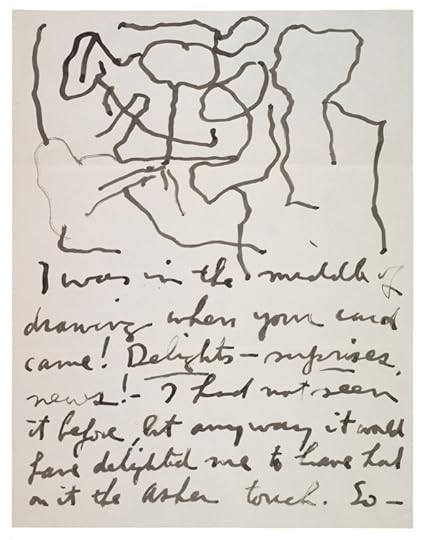
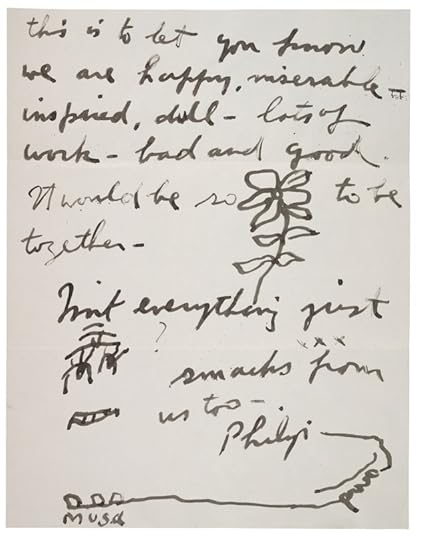
The painter Philip Guston’s 1964 letter to the painter-poet Elise Asher (Smithsonian’s Archives of American Art)
Dorothea Lange composed her letters like she might compose a photograph. Lange, who is best known for her photographs taken during the Great Depression, padded each sentence with sizable spaces, creating an unusual sense of rhythm in her 1957 letter to the social realist artist Ben Shahn. Her handwriting appears tidy but idiosyncratic, with architectural m’s and the occasional emphasis given to capital letters. Lange felt that her creativity, evident in both her handwriting and documentary photography, came from within. In her 1964 oral history interview for the Archives of American Art, Lange likened her artistic originality to the individuality of handwriting: “It may sound like an immensely egotistical thing to say: I’m not aware photographically of being influenced by anyone … Perhaps I would have done better had I been. But I haven’t … It’s my own handwriting.”
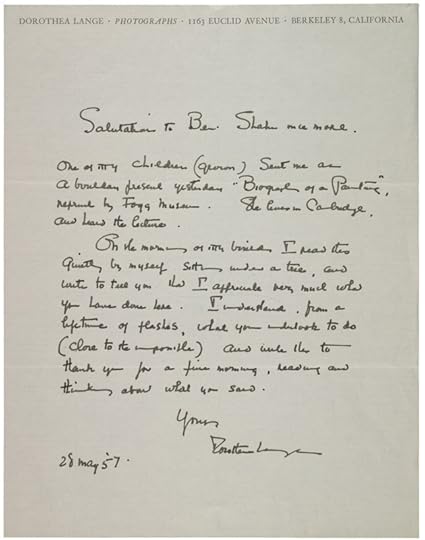
Dorothea Lange’s letter to Ben Shahn on May 28, 1957 (Smithsonian’s Archives of American Art)
In 1960, the painter Hans Hofmann wrote an empathetic letter of condolence to the curator Dorothy Canning Miller after the death of her husband, Holger Cahill. “We feel very strongly with you,” he writes. Hofmann’s spindly handwriting is measured as he balances the large capital D’s in “Dear Dorothy” with the two large capital H’s in his signature. From start to finish, the eye follows a diagonal path across the page. The control of movement is reminiscent of his abstract expressionist paintings, in which he famously juxtaposed shapes and colors to suggest a sense of spatial depth on the flat surface of a canvas.
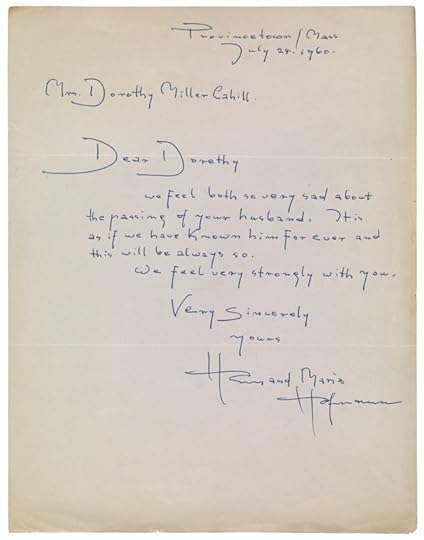
Hans Hofmann’s letter to Dorothy Canning Miller on July 24, 1960 (Smithsonian’s Archives of American Art)
For many artists, it is easy to see how writing is performative. Martha Graham, a pioneer of modern dance, choreographed her letterforms across the page in a 1923 letter to the photographer Nickolas Muray. “I’m trying to write very carefully,” she begins in arabesque strokes of ink.
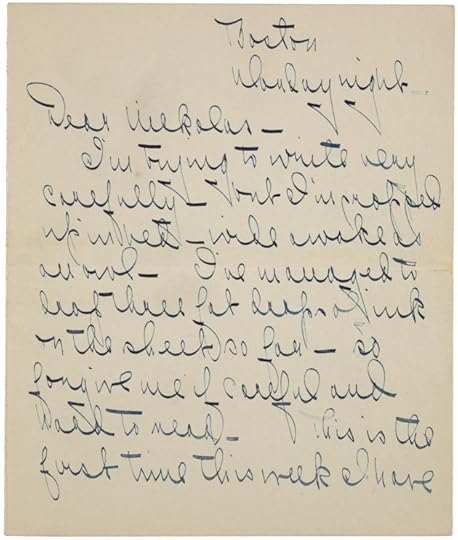
Martha Graham’s letter to Nickolas Muray, ca. 1923 (Smithsonian’s Archives of American Art)
Likewise, the poet-dancer-potter Paulus Berensohn, who studied dance with Graham at the Juilliard School in 1951, also poured his interest in movement into calligraphy. He taught an embodied method of writing to students at the Penland School of Crafts in North Carolina, encouraging complete revisions of one letterform at a time. His technique forced students out of their established physical habits to become newly alert to the lines of their letters. As soon as one letterform was relearned, the student would move on to another so that the handwriting—and the body—was always in transition. Berensohn’s copious letters to his friend and Penland colleague Jane Brown demonstrate his inflected handwriting. In a 2012 card to Brown marking the solstice, Berensohn’s letterforms are a deliberate mix of sharp angles and soft curves.

Paulus Berensohn’s greeting card to Jane Brown on December 21, 2012 (Smithsonian’s Archives of American Art)
For the painter Louis Michel Eilshemius, it was the limitation of physical movement that fostered his boisterous handwriting. A disabling car accident in 1932 confined Eilshemius to his home. A prolific writer, he devoted much of his energy to promoting his perceived contributions to society, such as his artwork, musical scores, and eccentric writings. The self-declared “Mahatma of the Art World” wrote daily letters to the editor of the New York Sun and to dealers, friends, and art world figures. His bombastic handwriting suggests his restless energy and alienation from the outside world. “I am half dead. So few visitors and I [am] neglected. Where is God,” he wrote to the dealer F. Valentine Dudensing around 1935.
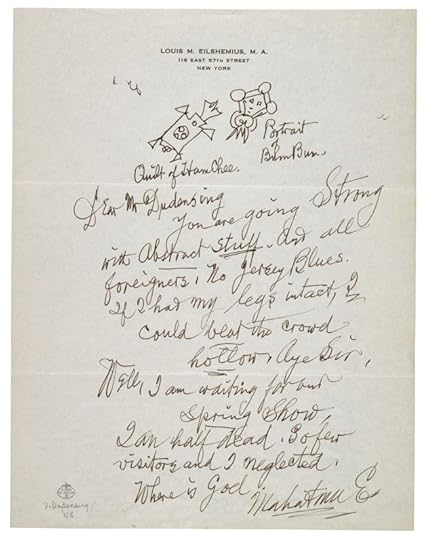
Louis Michel Eilshemius’s letter to F. Valentine Dudensing, ca. 1935 (Smithsonian’s Archives of American Art)
Handwritten missives create presence in the distance between two people: Letters are material evidence of a relationship. Take, for example, a 1796 letter from the portrait painter Lawrence Sully to his sister Elizabeth “Betsey” Middleton Smith. The lyrical ornamentation of Sully’s salutation and signature relays his affection for his sibling. The body of the letter is orderly and polite, as Sully explains how a series of “untoward events has precluded” his intentions to see Betsey and return her miniature portrait. At the time, Sully was on the brink of financial ruin, and yet his refined roundhand lettering helps to hedge conflict in his family.

Lawrence Sully’s letter to Elizabeth “Betsey” Middleton Smith on March 10, 1796 (Smithsonian’s Archives of American Art)
More than 150 years later, around 1952, Robert Rauschenberg wrote a more modern missive to painter Jack Tworkov. Rauschenberg’s words jumble together as he elaborates on photographs taken during their time together at Black Mountain College, where Tworkov was Rauschenberg’s instructor. “I will write again, but not so hurriedly next time,” he concludes. The loopy, informal lettering suggests Rauschenberg’s comfort with Tworkov. In both letters, handwriting helps narrow the physical distance between sender and recipient: Sully writes with genteel deliberation, and Rauschenberg writes with restless enthusiasm.
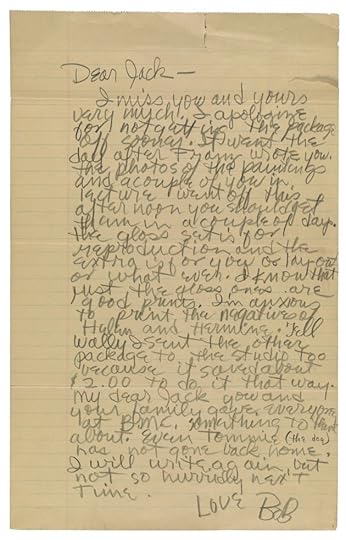
Robert Rauschenberg’s letter to Jack Tworkov, ca. 1952 (Robert Rauschenberg Foundation)
Artists often code their feelings through handwriting. Lines can be abraded, exaggerated, or compressed to approximate the writer’s emotional investment in the narrative of the letter. The Chilean painter Mario Carreño emphatically wrote in all caps in his 1982 correspondence to Cuban-American artist Enrique Riverón. The capital letters and accompanying illustrations convey Carreño’s intense reaction to a destructive flood in his neighborhood in Santiago de Chile.
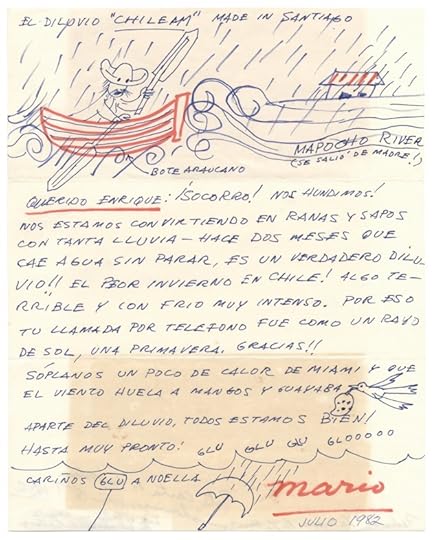
Mario Carreño’s letter to Enrique Riveron on July 18, 1982 (Smithsonian’s Archives of American Art)
Likewise, the abstract expressionist Elaine de Kooning writes in sinuous lines in an undated letter to the ARTnews editor Thomas Hess. Some words stretch into a nearly flat line, punctured by the occasional ascending or descending lines. De Kooning felt “aggrieved” and “oppressed” by recent events involving Hess. Perhaps de Kooning’s discomfort with the situation is manifest in her obfuscated handwriting.
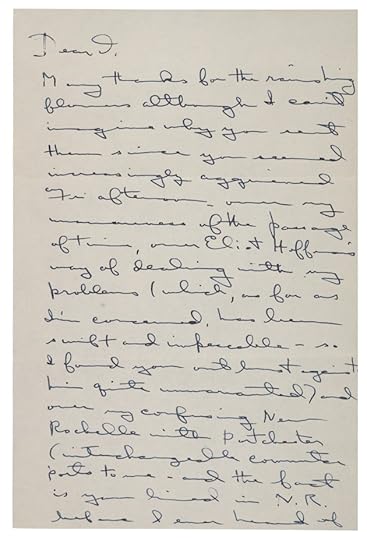
Elaine de Kooning’s letter to Thomas Hess, undated (Smithsonian’s Archives of American Art)
Artists also create a sense of place through handwriting. Photographer Berenice Abbott was amazed by her environs in Germany, and Harlem Renaissance painter Beauford Delaney’s vigorous missives indicate his quixotic mood in Paris. The painter George Catlin wrote quickly from the plains of Oklahoma, and self-taught artist Grandma Moses’s brambly cursive evokes everyday life on a farm.
Handwriting serves as an extension of an artist’s process. The fiber artist Lenore Tawney, the abstract painter Ad Reinhardt, and the modernist painter Abraham Rattner, among others, studied various styles of medieval and Asian calligraphy, and the artist-activist Corita Kent wanted to learn the Hebrew alphabet. Likewise, the Minimalist artist Dan Flavin scrupulously practiced Spencerian script. Hanne Darboven and H.C. Westermann expressed their artistic idioms through correspondence, blurring the line between archival document and art.
“There should be more letter writing than there is,” lamented the painter Paul Cadmus in a 1988 oral history interview for the Archives of American Art. Cadmus and his interviewer, Judd Tully, predicted the demise of personal correspondence. Cadmus explains, “It’s partly because Americans don’t have decent handwriting anymore.” Cadmus, who wrote in charming cursive, echoes the sentiments of many penmanship enthusiasts. Technologies of communication, from telegrams to texting, have long threatened the written word. Today, many primary schools are dropping lessons in longhand in favor of teaching technological skills.
Future generations of readers might look at letters with untrained eyes and find themselves unable to read the letters of Isamu Noguchi or John Singer Sargent. And yet, handwriting continues to prove its fluidity. The craft of handwriting has flourished online, especially on social media. Artists, thinkers, and makers alike are experimenting with penmanship in innovative ways. Demonstrations of calligraphy can be found on YouTube and hand-scribed cards flourish on Etsy. In the past few years, the curator Hans-Ulrich Obrist has rebooted autograph collecting by posting handwritten notes—usually jotted down on Post-it Notes—by contemporary artists on Instagram, where anyone is welcome to add comments.
With this in mind, let’s not mourn handwriting as a lost art, or even as a dying art. As snail mail fades from contemporary culture as a primary mode of communication, a vast array of handwritten letters remains relevant and ready for new generations to discover. Let’s celebrate how imaginative correspondence now exists in material and digital forms, posing new ways of thinking about art, history, and culture.
This article has been adapted from Mary Savig’s book, Pen to Paper: Artists’ Handwritten Letters from the Smithsonian’s Archives of American Art .

An End to FARC's 'Revolutionary Tax'

The leader of the Revolutionary Armed Forces of Colombia (FARC) ordered an end to its decades’-old “revolutionary tax” on local businesses in parts of Colombia under its control.
Rodrigo “Timochenko” Londoño, the Marxist guerrilla group’s leader, said Monday the tax was no longer needed because of the upcoming peace agreement with the Colombian government.
Colombia Reports quoted the FARC leader as saying:
“We hadn’t done this before not because of a lack of will but because we need to eat,” said Timochenko.
“We’re almost there and we believe that with what we have we will make it to the end,” the FARC chief added.
FARC was a political movement that later became a designated terrorist organization. To sustain itself, it long relied upon the extortion tax levied on businesses operating in areas it controls, as well as on kidnapping, illegal mining, and drug trafficking. FARC once counted 20,000 soldiers among its ranks. Its decades-long war with the government has killed more than 250,000 people, and displaced more than 6 million.
Last month Timochenko signed a cease-fire agreement with Colombian President Juan Manuel Santos in preparation of a peace treaty and full demobilization of the remaining 8,000 FARC soldiers. A peace deal is expected before the end of the month.

Atlantic Monthly Contributors's Blog
- Atlantic Monthly Contributors's profile
- 1 follower



